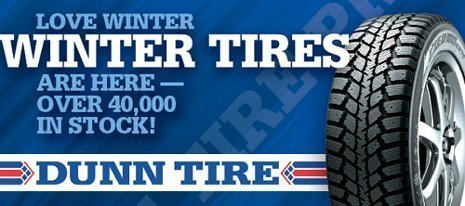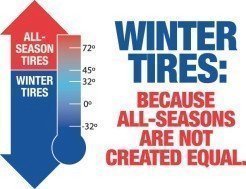Tire Safety
Winter Tires

Vital Information and Video on Winter Tires!
» Click here for video demonstrations
Why do I need Snow Tires?
Snow tires, also known as "winter tires" and "ice tires," are tires that have been designed and manufactured specifically to perform well under winter conditions. Winter tires are different from other tires in both their tread and the kind of rubber that they are made of. The rubber that is used to create winter tires is softer than tires that are used in summer conditions. The softer rubber grips ice and snow better than other tires and does not harden in cold conditions. This means when it's cold Winter tires will grip the road better even in clear, dry conditions.
The tread on snow tires is also much different than the tread on other types of tires. First of all, Winter tires have more grooves than most others. Like the soft rubber, these grooves also help the tires to grip snowy and icy roads.
On front-wheel-drive vehicles, winter tires must be fitted in complete sets of four tires. If high traction snow tires are mounted on the front and lower traction tires are mounted on the rear, the rear of the vehicle can lose traction during cornering or braking on snow or ice and spin out. This is a difficult condition for most drivers to control. Snow tires on all wheel positions will provide the most effective and safest winter

How Cold Temperature Affects Tires/Winter Tips
Every time the outside temperature drops 10 degrees Fahrenheit, the air pressure inside your tires goes down about one or two pounds per square inch.
You should check your tire pressures frequently during cold weather and add the necessary air to keep them at recommended levels of inflation at all times.
Never reduce tire pressures in an attempt to increase traction on snow or ice. It does not work and your tires will be so seriously underinflated that driving will damage them.
If one of the drive wheels becomes stuck, the centrifugal forces created by a rapidly spinning tire can cause an explosion by literally tearing the tire apart. Never exceed the 35 mph indicated speedometer speed. Do not stand near the spinning tire.
If your vehicle is stuck and a tow truck is not readily available, gently rock your vehicle back and forth, repeatedly shifting the gear lever from drive to reverse on automatic transmissions, or reverse to second on manual transmissions, while applying gentle pressure to the accelerator. Caution: If you have an anti-lock braking system (ABS) in your car, follow the operational instructions in your owner's manual.
Winter Driving Tips
Stay safe this winter by following some sensible rules when driving in slippery road conditions.
Winter Tire Vs. All Season Tires Performance Demonstration, produced by Rubber Manufacturers Association of Canada
Winter Tires - What Automotive Experts Say
According to Motortrend.com:
"It's best to replace all four tires with winter tires because differences in tire size and wear can negatively affect a car's handling and stability." "A modern snow tire can provide up to 20 percent better snow traction than an all-season design. We've verified this from behind the steering wheel. A well designed winter tire provides a tangible seat-of-the-pants performance advantage over all-season tires in both snow and ice conditions. This includes better initial hookup, shorter braking distances, and cornering that's both more predictable and controllable. This is important, since again according to Goodyear, "The largest group of [winter] accidents results from loss of lateral control of the car on ice and snow."
According to msn.com:
"What is most important is the level of improvement winter tires offer over standard all-season tires. Even at 15 mph, in tests we conducted on an icy surface, the vehicles equipped with winter tires stopped from a half to a full car-length shorter than identical vehicles on all-seasons. That could be the difference between a safe stop and a bumper-basher at a traffic light. At higher speeds, those differences get more dramatic."
"…similar improvements were apparent negotiating a loose slalom course—not unlike typical parking lot maneuvers. Not only were the vehicles on winter tires measurably faster (by 10 to 20 percent)—an indication of the added margin of traction they provide—but also they were noticeably easier to control."
"One of the keys to that performance improvement was the fact that those vehicles were equipped with four winter tires, not just two. Because of the significant differences in traction between winter and all-season tires, it is imperative that they be installed on all four wheels. Otherwise, the two ends of your vehicle can experience different traction characteristics, resulting in potentially dangerous instability."
According to Forbesauto.com:
"Even in all but the harshest of snowy conditions, a two-wheel-drive vehicle (whether front- or rear-driven) will perform safely and securely in snow with the proper snow tires mounted on all four wheels. Comparison tests performed by automotive-enthusiast magazines in the snow have shown that a 2WD drive vehicle with snow tires on all four wheels will outperform a 4WD vehicle with regular tires."
According to the Tire Industry Association:
"If winter tires are installed on the front axle of any vehicle, they must also be installed on the rear. The difference in traction qualities may result in adverse handling characteristics, which can lead to loss of vehicle control. Therefore, in order to maintain performance and stability, winter/snow tires must be installed on all four wheel positions on front-wheel drive vehicles."
According to Consumer Research Advocate
Though you might be tempted to buy just two winter tires for your drive axle, every expert we found says this isn't a great idea. That's because mixing winter and all-season tires can lead to poor handling balance. The Toronto Star's John Mahler says that this strategy can be dangerous in skid situations, as the front wheels get different traction than the rear wheels. All experts say four winter tires are your best bet, and even inexpensive winter tires will do better in ice and snow than all-season tires."
